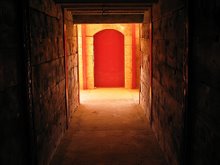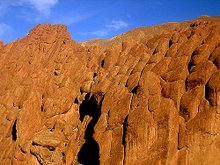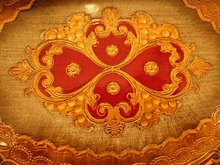
MUNICH, GERMANY -- May 27, 2006
(continued)
Thanks to Aaron, my Michigan-native, German-speaking guide, I learned that Munich is where Nazi Germany got its start, but that Munich was first founded by Henry the Lion in the 1100´s (which explains the abundance of lions on display throughout the city), and that the name Munchen (which is the actual name for English-derived Munich), comes from an expression meaning "near the monks," because monks had been living here for over a hundred years before Henry founded Munchen.
Peeking inside several of the churches clustered around Marienplatz, Aaron pointed out the monk icons set in plaster on ceilings, walls, and doorways. We moved across the street to the Viktualienmarkt, where, it became obvious, the parade had convened. The square was buzzing with locals clanging beer steins, chugging to the sounds of trombones oompahing in the adjuacent biergarten, and throngs more pushed against a counter along which two grtizzly beertappers were slinging glasses filled with yellow, frothy liquid by the dozens, free for the taking. The air smelled of sausage and sauerkraut and, giving in to my whims, I ordered up a bratwurst of my own.
 I chatted with a few travellers also on the tour -- Tim from St. Charles, MO (what are the odds of that??) and Kerry, an Aussie on 6-month holiday before returning to London, where she has been working for the past 3 years. Leaving them, I wandered through the food stands and horse carts, wrapped up in the ambience of this heady celebration, not realizing that my tour group had left without me. I scouted around for them for a few minutes, and then headed for Old St. Peter´s without them. St Peter´s, the oldest standing church in Munchen, houses a 306-step church tower that offers the best views of the city. From my high perch, I could see even a hint of the Alps, which are 1.5 hours away.
I chatted with a few travellers also on the tour -- Tim from St. Charles, MO (what are the odds of that??) and Kerry, an Aussie on 6-month holiday before returning to London, where she has been working for the past 3 years. Leaving them, I wandered through the food stands and horse carts, wrapped up in the ambience of this heady celebration, not realizing that my tour group had left without me. I scouted around for them for a few minutes, and then headed for Old St. Peter´s without them. St Peter´s, the oldest standing church in Munchen, houses a 306-step church tower that offers the best views of the city. From my high perch, I could see even a hint of the Alps, which are 1.5 hours away.I headed to the famous Englischer Garten (the largest metropolitan park in Europe!), passing the Residenz (where Bavarian rulers lived from the 14th century until less than 100 years ago), and the nearby Hofgarten, where locals relaxed under shady trees sipping beers. As I walked along Schwabinger Bach in Englischer Garten, I passed tranquil ponds with flapping ducks and graceful swans, cascading waterfalls, and open stretches of grass dotted with sunbathers, until I arrived at the Chinesier Turm (Chinese Tower), one of the park´s famous biergartens. Here, under the shady brances of stories-tall trees, locals and toursits relaxed with a good drink and perhaps a drumstick, bratwurst, or oversized pretzel, while a band played merrily from the tower´s upper platforms.
 Looking ahead of me, I saw a familar face approaching through the crowd. It was Kerry, the Aussie traveler I had met earlier in the day. We continued together through the garden until we arrived at the northern end, near a lake where couples perused the waters in covered paddleboats. The sky, which had been growing darker, broke its silence with a furious rainstorm, saturating everything in its path. We took shelter under a tree and chatted about the deeper subjects of life, waiting for the rain to ease up. An hour later, despite the storm, we decided to hoof back to the city and find a coffeeshop where we could dry off a bit.
Looking ahead of me, I saw a familar face approaching through the crowd. It was Kerry, the Aussie traveler I had met earlier in the day. We continued together through the garden until we arrived at the northern end, near a lake where couples perused the waters in covered paddleboats. The sky, which had been growing darker, broke its silence with a furious rainstorm, saturating everything in its path. We took shelter under a tree and chatted about the deeper subjects of life, waiting for the rain to ease up. An hour later, despite the storm, we decided to hoof back to the city and find a coffeeshop where we could dry off a bit.En route, we passed the spot along the river where surfers -- yes, surfers! -- donning wetsuits rode the white water waves which kicked up at the river´s bend. Over a mango lassi (ahhhh.... Indian food....) we swapped life stories, and I found myself drawn to this woman who shared so many of my hopes, dreams, and experiences. It was refreshing to really connect with someone -- beyond the on-the-surface conversation I often have with others I meet. She left me with a list of book titles to continue my self-exploration as I travel onward.
As if today hadn´t been fully enough, I happened to cross paths with an American traveler named Jeff, who between his cheesy jokes and even cheesier pickup lines, managed to talk me into a night on the town in Munich. We scammed a few rides on the U-bahn (subway) to Marienplatz, and wandered around until we found the famous Hofbrauhaus, one of Munich´s oldest -- and certainly most famous --- beer halls. This is the one those Glockenspiel characters were twirling about, and it didn´t take long for us to discover why. Row after row of wooden benches, filled to the gills with smiling patrons, stretched across the large beer house from one wall to the other. Yet another oompah band played jovially from a simple stage, and merry voices at nearby tables joined in as they neared the chorus. Above the din of clattering mugs and excited conversatin, aproned beer maids scibbled orders for traditional Bavarian chow -- roasted log of chicken, plates of cold salamis and cheeses, bratwurst with host mustard sauce and sides of sauerkraut.
 We seated ourselves at a table, empty except for one scruffy older gentleman wielding his own silver beer stein. In pure German, he tried to explain (we think!) that this was a reserved table, but as he was leaving momentarily, we were welcome to stay. Realizing our mistake, we got up to leave. But Adolf must ahve had a bit too much to drink, because he plunged his fist into the hard oak table and ordered, "Nein!" (NO!) Sheepishly, we settled back into our seats, and felt a tinge of relif when he headed out into the night.
We seated ourselves at a table, empty except for one scruffy older gentleman wielding his own silver beer stein. In pure German, he tried to explain (we think!) that this was a reserved table, but as he was leaving momentarily, we were welcome to stay. Realizing our mistake, we got up to leave. But Adolf must ahve had a bit too much to drink, because he plunged his fist into the hard oak table and ordered, "Nein!" (NO!) Sheepishly, we settled back into our seats, and felt a tinge of relif when he headed out into the night.We ordered up a few mugs of the house brew, which cost a handsome 6 eurose each, and were served in a Liter-sized mug, along with a few shots of the anise-flavored, very German Jägermeister to round our our salty dinner plates.
Munich far exceeded my expectations, and it´s no wonder to me now that it´s the capital of the most visited region of Germany, Bavaria. It lacks the big-city stuffiness taht so often accompanies a big metropolis, yet it is the third largest city in all of Germany, outranked only by Berlin and Hamburg. Munich, I´ll raise my mug to you any time!
~Melanie











































